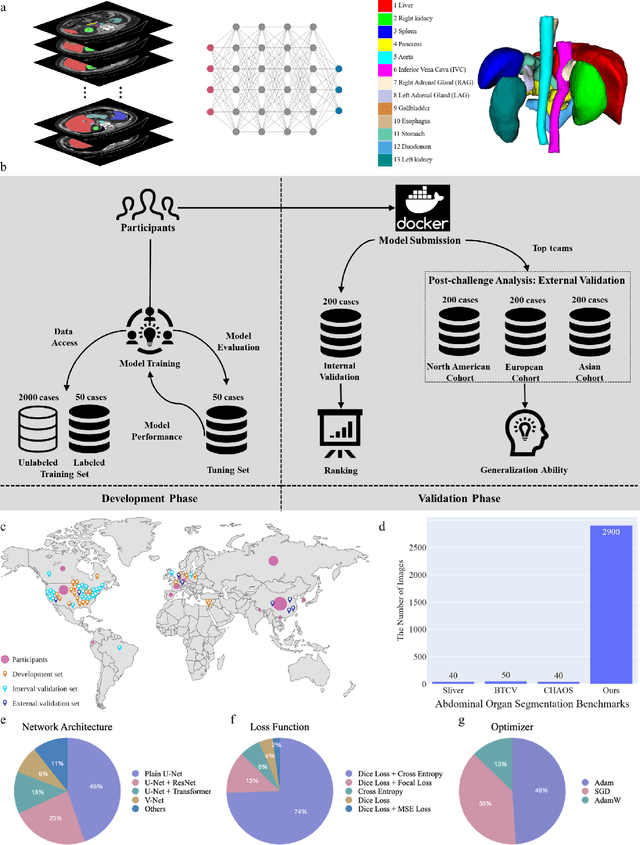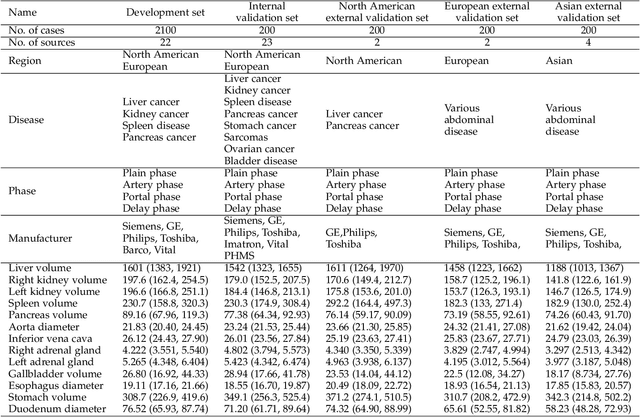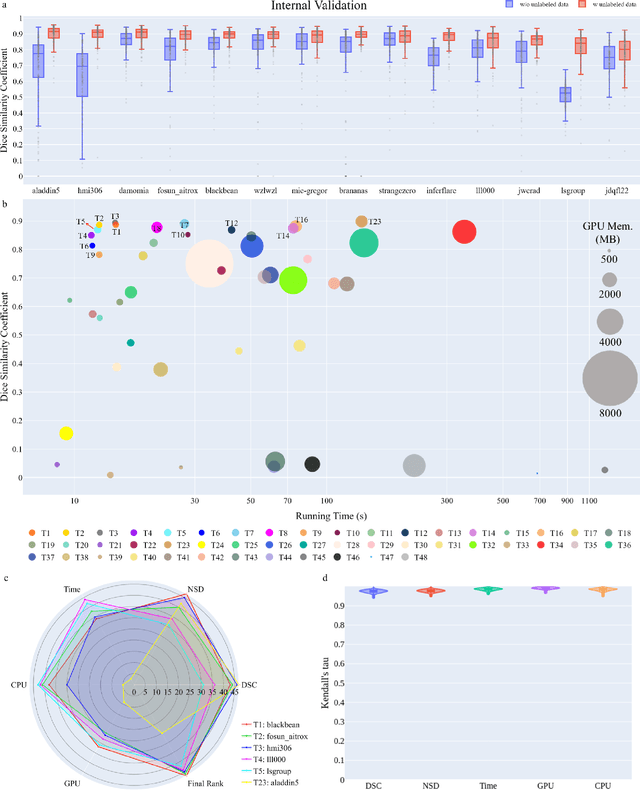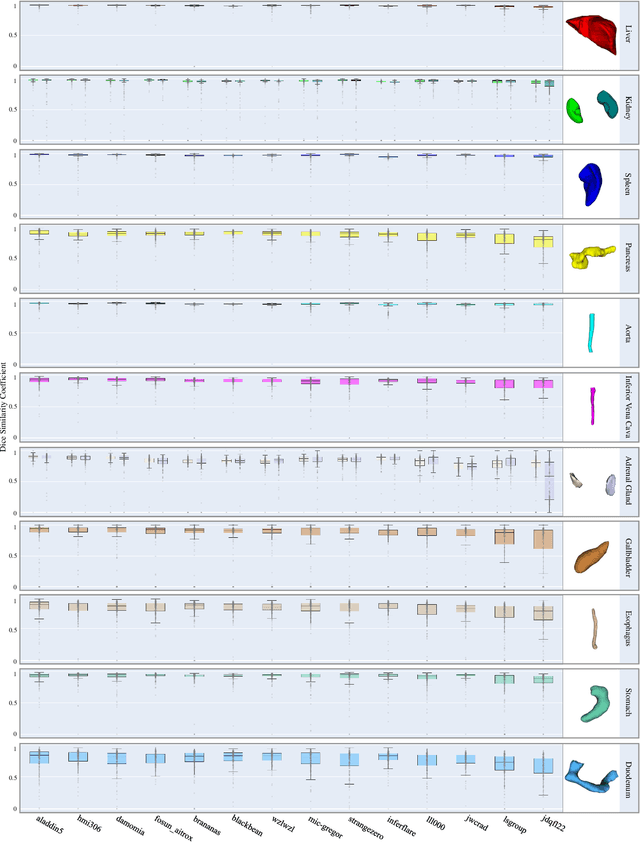Weixin Xu
Kimi K2: Open Agentic Intelligence
Jul 28, 2025Abstract:We introduce Kimi K2, a Mixture-of-Experts (MoE) large language model with 32 billion activated parameters and 1 trillion total parameters. We propose the MuonClip optimizer, which improves upon Muon with a novel QK-clip technique to address training instability while enjoying the advanced token efficiency of Muon. Based on MuonClip, K2 was pre-trained on 15.5 trillion tokens with zero loss spike. During post-training, K2 undergoes a multi-stage post-training process, highlighted by a large-scale agentic data synthesis pipeline and a joint reinforcement learning (RL) stage, where the model improves its capabilities through interactions with real and synthetic environments. Kimi K2 achieves state-of-the-art performance among open-source non-thinking models, with strengths in agentic capabilities. Notably, K2 obtains 66.1 on Tau2-Bench, 76.5 on ACEBench (En), 65.8 on SWE-Bench Verified, and 47.3 on SWE-Bench Multilingual -- surpassing most open and closed-sourced baselines in non-thinking settings. It also exhibits strong capabilities in coding, mathematics, and reasoning tasks, with a score of 53.7 on LiveCodeBench v6, 49.5 on AIME 2025, 75.1 on GPQA-Diamond, and 27.1 on OJBench, all without extended thinking. These results position Kimi K2 as one of the most capable open-source large language models to date, particularly in software engineering and agentic tasks. We release our base and post-trained model checkpoints to facilitate future research and applications of agentic intelligence.
Kimi-VL Technical Report
Apr 10, 2025Abstract:We present Kimi-VL, an efficient open-source Mixture-of-Experts (MoE) vision-language model (VLM) that offers advanced multimodal reasoning, long-context understanding, and strong agent capabilities - all while activating only 2.8B parameters in its language decoder (Kimi-VL-A3B). Kimi-VL demonstrates strong performance across challenging domains: as a general-purpose VLM, Kimi-VL excels in multi-turn agent tasks (e.g., OSWorld), matching flagship models. Furthermore, it exhibits remarkable capabilities across diverse challenging vision language tasks, including college-level image and video comprehension, OCR, mathematical reasoning, and multi-image understanding. In comparative evaluations, it effectively competes with cutting-edge efficient VLMs such as GPT-4o-mini, Qwen2.5-VL-7B, and Gemma-3-12B-IT, while surpassing GPT-4o in several key domains. Kimi-VL also advances in processing long contexts and perceiving clearly. With a 128K extended context window, Kimi-VL can process diverse long inputs, achieving impressive scores of 64.5 on LongVideoBench and 35.1 on MMLongBench-Doc. Its native-resolution vision encoder, MoonViT, further allows it to see and understand ultra-high-resolution visual inputs, achieving 83.2 on InfoVQA and 34.5 on ScreenSpot-Pro, while maintaining lower computational cost for common tasks. Building upon Kimi-VL, we introduce an advanced long-thinking variant: Kimi-VL-Thinking. Developed through long chain-of-thought (CoT) supervised fine-tuning (SFT) and reinforcement learning (RL), this model exhibits strong long-horizon reasoning capabilities. It achieves scores of 61.7 on MMMU, 36.8 on MathVision, and 71.3 on MathVista while maintaining the compact 2.8B activated LLM parameters, setting a new standard for efficient multimodal thinking models. Code and models are publicly accessible at https://github.com/MoonshotAI/Kimi-VL.
Muon is Scalable for LLM Training
Feb 24, 2025Abstract:Recently, the Muon optimizer based on matrix orthogonalization has demonstrated strong results in training small-scale language models, but the scalability to larger models has not been proven. We identify two crucial techniques for scaling up Muon: (1) adding weight decay and (2) carefully adjusting the per-parameter update scale. These techniques allow Muon to work out-of-the-box on large-scale training without the need of hyper-parameter tuning. Scaling law experiments indicate that Muon achieves $\sim\!2\times$ computational efficiency compared to AdamW with compute optimal training. Based on these improvements, we introduce Moonlight, a 3B/16B-parameter Mixture-of-Expert (MoE) model trained with 5.7T tokens using Muon. Our model improves the current Pareto frontier, achieving better performance with much fewer training FLOPs compared to prior models. We open-source our distributed Muon implementation that is memory optimal and communication efficient. We also release the pretrained, instruction-tuned, and intermediate checkpoints to support future research.
Unleashing the Strengths of Unlabeled Data in Pan-cancer Abdominal Organ Quantification: the FLARE22 Challenge
Aug 10, 2023



Abstract:Quantitative organ assessment is an essential step in automated abdominal disease diagnosis and treatment planning. Artificial intelligence (AI) has shown great potential to automatize this process. However, most existing AI algorithms rely on many expert annotations and lack a comprehensive evaluation of accuracy and efficiency in real-world multinational settings. To overcome these limitations, we organized the FLARE 2022 Challenge, the largest abdominal organ analysis challenge to date, to benchmark fast, low-resource, accurate, annotation-efficient, and generalized AI algorithms. We constructed an intercontinental and multinational dataset from more than 50 medical groups, including Computed Tomography (CT) scans with different races, diseases, phases, and manufacturers. We independently validated that a set of AI algorithms achieved a median Dice Similarity Coefficient (DSC) of 90.0\% by using 50 labeled scans and 2000 unlabeled scans, which can significantly reduce annotation requirements. The best-performing algorithms successfully generalized to holdout external validation sets, achieving a median DSC of 89.5\%, 90.9\%, and 88.3\% on North American, European, and Asian cohorts, respectively. They also enabled automatic extraction of key organ biology features, which was labor-intensive with traditional manual measurements. This opens the potential to use unlabeled data to boost performance and alleviate annotation shortages for modern AI models.
PVD-AL: Progressive Volume Distillation with Active Learning for Efficient Conversion Between Different NeRF Architectures
Apr 08, 2023Abstract:Neural Radiance Fields (NeRF) have been widely adopted as practical and versatile representations for 3D scenes, facilitating various downstream tasks. However, different architectures, including plain Multi-Layer Perceptron (MLP), Tensors, low-rank Tensors, Hashtables, and their compositions, have their trade-offs. For instance, Hashtables-based representations allow for faster rendering but lack clear geometric meaning, making spatial-relation-aware editing challenging. To address this limitation and maximize the potential of each architecture, we propose Progressive Volume Distillation with Active Learning (PVD-AL), a systematic distillation method that enables any-to-any conversions between different architectures. PVD-AL decomposes each structure into two parts and progressively performs distillation from shallower to deeper volume representation, leveraging effective information retrieved from the rendering process. Additionally, a Three-Levels of active learning technique provides continuous feedback during the distillation process, resulting in high-performance results. Empirical evidence is presented to validate our method on multiple benchmark datasets. For example, PVD-AL can distill an MLP-based model from a Hashtables-based model at a 10~20X faster speed and 0.8dB~2dB higher PSNR than training the NeRF model from scratch. Moreover, PVD-AL permits the fusion of diverse features among distinct structures, enabling models with multiple editing properties and providing a more efficient model to meet real-time requirements. Project website:http://sk-fun.fun/PVD-AL.
OccDepth: A Depth-Aware Method for 3D Semantic Scene Completion
Feb 27, 2023Abstract:3D Semantic Scene Completion (SSC) can provide dense geometric and semantic scene representations, which can be applied in the field of autonomous driving and robotic systems. It is challenging to estimate the complete geometry and semantics of a scene solely from visual images, and accurate depth information is crucial for restoring 3D geometry. In this paper, we propose the first stereo SSC method named OccDepth, which fully exploits implicit depth information from stereo images (or RGBD images) to help the recovery of 3D geometric structures. The Stereo Soft Feature Assignment (Stereo-SFA) module is proposed to better fuse 3D depth-aware features by implicitly learning the correlation between stereo images. In particular, when the input are RGBD image, a virtual stereo images can be generated through original RGB image and depth map. Besides, the Occupancy Aware Depth (OAD) module is used to obtain geometry-aware 3D features by knowledge distillation using pre-trained depth models. In addition, a reformed TartanAir benchmark, named SemanticTartanAir, is provided in this paper for further testing our OccDepth method on SSC task. Compared with the state-of-the-art RGB-inferred SSC method, extensive experiments on SemanticKITTI show that our OccDepth method achieves superior performance with improving +4.82% mIoU, of which +2.49% mIoU comes from stereo images and +2.33% mIoU comes from our proposed depth-aware method. Our code and trained models are available at https://github.com/megvii-research/OccDepth.
One is All: Bridging the Gap Between Neural Radiance Fields Architectures with Progressive Volume Distillation
Nov 30, 2022Abstract:Neural Radiance Fields (NeRF) methods have proved effective as compact, high-quality and versatile representations for 3D scenes, and enable downstream tasks such as editing, retrieval, navigation, etc. Various neural architectures are vying for the core structure of NeRF, including the plain Multi-Layer Perceptron (MLP), sparse tensors, low-rank tensors, hashtables and their compositions. Each of these representations has its particular set of trade-offs. For example, the hashtable-based representations admit faster training and rendering but their lack of clear geometric meaning hampers downstream tasks like spatial-relation-aware editing. In this paper, we propose Progressive Volume Distillation (PVD), a systematic distillation method that allows any-to-any conversions between different architectures, including MLP, sparse or low-rank tensors, hashtables and their compositions. PVD consequently empowers downstream applications to optimally adapt the neural representations for the task at hand in a post hoc fashion. The conversions are fast, as distillation is progressively performed on different levels of volume representations, from shallower to deeper. We also employ special treatment of density to deal with its specific numerical instability problem. Empirical evidence is presented to validate our method on the NeRF-Synthetic, LLFF and TanksAndTemples datasets. For example, with PVD, an MLP-based NeRF model can be distilled from a hashtable-based Instant-NGP model at a 10X~20X faster speed than being trained the original NeRF from scratch, while achieving a superior level of synthesis quality. Code is available at https://github.com/megvii-research/AAAI2023-PVD.
Arch-Net: Model Distillation for Architecture Agnostic Model Deployment
Nov 01, 2021



Abstract:Vast requirement of computation power of Deep Neural Networks is a major hurdle to their real world applications. Many recent Application Specific Integrated Circuit (ASIC) chips feature dedicated hardware support for Neural Network Acceleration. However, as ASICs take multiple years to develop, they are inevitably out-paced by the latest development in Neural Architecture Research. For example, Transformer Networks do not have native support on many popular chips, and hence are difficult to deploy. In this paper, we propose Arch-Net, a family of Neural Networks made up of only operators efficiently supported across most architectures of ASICs. When a Arch-Net is produced, less common network constructs, like Layer Normalization and Embedding Layers, are eliminated in a progressive manner through label-free Blockwise Model Distillation, while performing sub-eight bit quantization at the same time to maximize performance. Empirical results on machine translation and image classification tasks confirm that we can transform latest developed Neural Architectures into fast running and as-accurate Arch-Net, ready for deployment on multiple mass-produced ASIC chips. The code will be available at https://github.com/megvii-research/Arch-Net.
 Add to Chrome
Add to Chrome Add to Firefox
Add to Firefox Add to Edge
Add to Edge